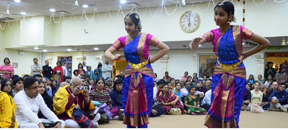 LEMONT: Maha Shivaratri, the ‘Great Night of Shiva’ one of the trinity of Hindu Gods, was celebrated with fervor at the Hindu Temple of Greater Chicago, Lemont, as a three-day festival.
LEMONT: Maha Shivaratri, the ‘Great Night of Shiva’ one of the trinity of Hindu Gods, was celebrated with fervor at the Hindu Temple of Greater Chicago, Lemont, as a three-day festival.
The festival started on February 25 with a traditional Ganesha Homa. Over the next three days, the homa continued twice a day along with the chanting of Shiva Pancha Bramha Mantra. On the actual Shivaratri Day, February 27, Lord Shiva was worshipped by offering 108 Kalashãbhisheka and Bilvarchana. Later that day, after Mahãnyasam and Maha Sankalpam, the Lord was offered eleven abhishekams that started at 9 pm. During the four kaalas (time-periods), the Lord was offered different varieties of dravyas (special substances).
For each kaala, the Lord was resplendent in a distinctly ornate alankara that was created by using grains, unguents (chandan), clothes, flowers, etc. The alankaras were created with great attention to detail, aesthetics, and spiritual significance.
Devotees in thousands thronged to receive the blessings of Lord Ramalingeshwara, the presiding deity at the temple. A three-foot tall ice-sculpture of Lord Shiva was a major attraction that welcomed devotees at the door.
All through the night (till the final arati at 6:00 am, sangeethopacharam (spiritual service through music) was performed by Lemont Thirumural Group along with many other temple volunteers, all of whom rendered melodious bhajans. Nrityopacharam (spiritual service through dance) was performed by students of Nrityanjanli School of Dance. The Ayyappa Seva Mandalam offered vibrant chenda-vaadya (traditional music of drums from the state of Kerala in India) and bhajans as well. With great devotion, priests and devotees alike chanted Rudram, Chamakam, Vedaghosa, Shodashopacharas (special devotional chants for Lord Shiva) during the abhishekas and alankaras.
A grand Girija Kalyanam was performed on March 1. The Kalyanam (marriage) celebrated the celestial couple of Shiva and his consort, Parvati, through a reenactment of their wedding ceremonies and rituals. The bride and the groom, bedecked in flowers were seated on a lion and a bull – their respective vehicles and taken out in a procession around the temple.
The traditional exchange of wedding garlands took place accompanied by lively music and dance, performed by students of Nritya Sangeet Dance School. Special sweets and savories were prepared for the occasion in the temple’s kitchen, and at the end of the wedding ceremonies, about 200 devotees were treated to Kalyana Bhojanam.
Devotees also attended the cultural program that followed, which brought the Maha Shivaratri celebrations to a close. This year’s Shivaratri festival was a grand success, thanks to the efforts of the priests, committee members, and many volunteers.
Raghu Baddi






